Mulch Treatment Effect on Weed Biomass and Yields of Organic Sweetpotato Cultivars
Abstract
:1. Introduction
2. Methods
2.1. Field Preparation, Planting, and Harvesting
2.2. Harvesting, Sorting, Curing, Storage, and Data Collection
2.3. Statistical Analysis
3. Results
4. Discussion
4.1. Weeds, Soil Temperature, and Mulch Treatment
4.2. Vine Lengths and Yield Components
5. Conclusions
Author Contributions
Funding
Acknowledgments
Conflicts of Interest
References
- Monks, D.W.; Schultheis, J.R.; Mills, R.J. Effects of weeds and herbicides on sweetpotato (Ipomoea batatas) transplant production using polyethylene bed covers. Weed Technol. 1996, 10, 273–277. [Google Scholar] [CrossRef]
- Schonbeck, M. An Ecological Understanding of Weeds. Extension Issues, Innovation and Impact. 2013. Available online: http://articles.extension.org/pages/18529/an-ecological-understanding-of-weeds (accessed on 10 February 2017).
- Benedict, L.; Smith, T.; Donnie, K.M. Effect of Herbicide Regimes on Weed Density and Yield in Sweetpotato. La Agric. 2006, 49, 20. [Google Scholar]
- Finney, D.M.; Creamer, N. Weed Management on Organic Farms; North Carolina Cooperative Extension Service: Raleigh, NC, USA, 2008; E06-45788; p. 34. Available online: http://web.extension.illinois.edu/smallfarm/downloads/55384.pdf (accessed on 10 February 2017).
- Jackson, D.M.; Harrison, H.F. Effects of a killed-cover crop mulching system on sweetpotato production, soil pests, and insect predators in South Carolina. J. Econ. Entomol. 2008, 101, 1871–1880. [Google Scholar] [CrossRef]
- McErlich, A.F.; Boydston, R.A. Current state of weed management in organic and conventional cropping systems. In Automation: The Future of Weed Control in Cropping Systems; Springer: Dordrecht, The Netherlands, 2014; pp. 11–32. [Google Scholar]
- Workayehu, T.; Mazengia, W.; Hidoto, L. Growth habit, plant density and weed control on weed and root yield of sweetpotato (Ipomoea batatas L.) Areka, Southern Ethiopia. J. Hortic. For. 2011, 3, 251–258. [Google Scholar]
- Lugo-Torres, M.D.L.; Díaz, M. Weed control in sweetpotato [Ipomoea batatas (L.) Lam.]. J. Agric. Univ. Puerto Rico 2007, 91, 161–167. [Google Scholar]
- North Carolina Sweetpotato Commission. Weeds. 2017. Available online: http://www.ncsweetpotatoes.com/sweet-potato-industry/growing-sweet-potatoes-in-north-carolina/weeds (accessed on 10 February 2017).
- Glaze, N.C.; Hall, M. Cultivation and herbicides for weed control in sweetpotato (Ipomoea batatas). Weed Technol. 1990, 4, 518–523. [Google Scholar] [CrossRef]
- Seem, J.E.; Creamer, N.G.; Monks, D.W. Critical weed-free period for ‘Beauregard’ sweetpotato (Ipomoea batatas). Weed Technol. 2003, 17, 686–695. [Google Scholar] [CrossRef]
- Adam, L.K. Sweetpotato. Organic Production. The National Sustainable Agriculture Information Service, 2005. ATTRA 1-800-346-9140. Available online: http://attra.ncat.org/attra-pub/sweetpotato.html (accessed on 10 February 2017).
- Hooks, R.C.; Leslie, W.A.; Chen, G. Managing Weeds in Vegetables Organically. 2016, pp. 1–18. Available online: https://extension.umd.edu/sites/extension.umd.edu/files/_images/programs/mdvegetables/OrganicWeedMgntVeg21May2016(1).pdf (accessed on 10 April 2019).
- Onwueme, I.C. The Tropical Tuber Crops Yam, Cassava, Sweetpotato and Cocoyams; John Willey and Sons: New York, NY, USA, 1978; p. 234. [Google Scholar]
- Sangakkara, U.R.; Attanayake, K.B.; Gajanayake, J.N.; Bandaranayake, P.S.D.R. Impact of mulches on growth and yields of cassava and sweetpotato in tropical Asia. In Proceedings of the 4th International Crop Science Congress, Brisbane, Australia, 26 September–1 October 2004. [Google Scholar]
- Schonbeck, M.; Tillage, B. Principles of Sustainable Weed Management in Organic Cropping Systems. In Workshop for Farmers and Agricultural Professionals on Sustainable Weed Management, 3rd ed.; Clemson University: Clemson, SC, USA, 2011; Available online: https://www.clemson.edu/public/sustainableag/pdfs/weedmanagement.pdf (accessed on 10 February 2017).
- Merwin, I.A.; Rosenberger, D.A.; Engle, C.A.; Rist, D.L.; Fargione, M. Comparing mulches, herbicides, and cultivation as orchard groundcover management systems. HortTechnology 1995, 5, 151–158. [Google Scholar] [CrossRef]
- Ayanaba, A.; Okigbo, B.N. Mulching for Improved Fertility and Crop Production; FAO Soils Bulletin; FAO: Rome, Italy, 1975; Volume 27, pp. 97–120. [Google Scholar]
- Laurie, S.M.; Maja, M.N.; Ngobeni, H.M.; Du Plooy, C.P. Effect of Different Type Mulching and Plant Spacing on Weed Control, Canopy Cover and Yield of Sweetpotato (Ipomoea batatas (L.) Lam). Am. J. Exp. Agric. 2015, 5, 450–458. [Google Scholar]
- Runham, S. Clear Edge for Paper Mulch; Grower, Nexus Horticulture: Swanley, UK, 1998; Volume 129, pp. 21–22. [Google Scholar]
- FeManrique, K.; Hermann, M. Effect of GxE Interaction on Root Yield and Beta-carotene Content of Selected Sweetpotato (Ipomoea batatas (L.) Lam.) Varieties and Breeding Clones; International Potato Center: Lima, Peru, 2000; 1999–2000 CIP Annual Report; pp. 281–287. [Google Scholar]
- Collins, W.; Wilson, W.G.; Arrendel, S.; Dickey, L.F. Genotype x environment interactions in sweetpotato yield and quality factors. J. Am. Soc. Hortic. Sci. 1987, 112, 579–583. [Google Scholar]
- Semidey, N.; Lui, L.C.; Ortiz, F.H. Competition of pigweed (Amaranthus dubius) with sweetpotato (Ipomoea batatas). J. Agric. Univ. Puerto Rico 1987, 71, 7–11. [Google Scholar]
- Central Agricultural Census Commission (CACC). Ethiopian Agricultural Sample Enumeration, 2001/02 (1994 EC): Report on the Preliminary Results of Area, Production and Yield of Temporary Crops; Central Statistical Authority (CSA): Addis Ababa, Ethiopia, 2003; p. 167.
- Ogbologwung, L.P.; Okpara, D.A.; Njoku, J.C. Effect of plant spacing and variety on weed and performance of orange-fleshed sweetpotato in humid agro-ecological zone of Nigeria. Uganda J. Agric. Sci. 2016, 17, 11–20. [Google Scholar]
- Harrison, H.F.; Jackson, D.M. Response of two sweetpotato cultivars to weed interference. Crop Prot. 2011, 30, 1291–1296. [Google Scholar] [CrossRef]
- Workayehu, T. Canopy structure weeding frequency plant density on weed and tuber yield of sweetpotato (Ipomoea batatas L.) Awassa, Southern Ethiopia. Afr. J. Food Sci. Technol. 2012, 3, 168–175. [Google Scholar]
- Lewthwaite, S.L.; Triggs, C.M.; Scheffer, J.J. Evaluation of alternative herbicide systems for the sweetpotato crop. In Proceedings of the 17th Australasian Weeds Conference, Christchurch, New Zealand, 26–30 September 2010. [Google Scholar]
- Meyers, S.L.; Shankle, M.W. Nutsedge Management in Mississippi Sweetpotatoes. Mississipi State University Extension Service. Publication 2909 (POD-09-15). 2015. Available online: https://extension.msstate.edu/sites/default/files/publications/publications/p2909.pdf (accessed on 10 February 2017).
- Sánchez, E.; Lamont, W.J.; Orzolek, M.D. Newspaper mulches for suppressing weeds for organic high-tunnel cucumber production. HortTechnology 2008, 18, 154–157. [Google Scholar] [CrossRef]
- Ferrara, G.; Fracchiolla, M.; Camposeo, S.; Lasorella, C.; Pacifico, A.; Aly, A.; Montemurro, P. Effects of Mulching Materials on Soil and Performance of cv. Uva di Troia Grapevines in Apulia region, Southeastern Italy. Am. J. Enol. Vitic. 2012, 63, 269–276. [Google Scholar] [CrossRef]
- Reinhardt, C.F.; Meissner, R.; Nel, P.C. Allelopathic effect of sweetpotato (Ipomoea batatas) cultivars on certain weed and vegetable species. South Afr. J. Plant Soil 1993, 10, 41–44. [Google Scholar] [CrossRef]
- Ossom, E.M.; Rhykerd, R.L. Effects of lime on weed species diversity and yield of sweetpotato [Ipomoea batatas (L.) Lam.] in Swaziland. Int. J. Agric. Biol. 2007, 9, 755–758. [Google Scholar]
- Korieocha, D.S. Weed Control in National Root Crops Research Institute Umudike and its Recommendation. Res. J. Agric. Environ. Manag. 2014, 4, 001–004. [Google Scholar]
- Workatyehu, T. Canopy structure and plant density: Their effect on weed and root yield of sweetpotato, Areka, Southern Ethiopia. In International Conference on Sweetpotato; Food and Health for the Future: Lima, Peru, 2001; Volume 19, pp. 171–178. [Google Scholar]
- Coolong, T.; Seebold, K.; Bessin, R.; Woods, T.; Fannin, S. Sweetpotato Production for Kentucky; Cooperative Extension Service, University of Kentucky College of Agriculture: Lexington, KY, USA, 2012; ID-195; Available online: http://www2.ca.uky.edu/agcomm/pubs/id/id195/id195.pdf (accessed on 10 February 2017).
- USDA Agricultural Marketing Service. USDA National Organic Program; USDA Agricultural Marketing Service: Washington, DC, USA, 2015. Available online: https://www.ams.usda.gov/sites/default/files/media/NOSB%20Fact% 20Sheet.pdf (accessed on 10 February 2017).
- Dumbuya, G. Effect of Tillage, Vine Length and Fertilizer Application on the Growth, Yield and Quality of Sweetpotato (Ipomoea batatas (L) Lam). Ph.D. Thesis, Kwame Nkrumah University of Science and Technology, Kumasi, Ghana, 2015. [Google Scholar]
- Singh, A.; Singh, M.; Singh, D.V.; Singh, M. Relative efficacy of organic mulch and herbicides for weed control in Cymbopogon species. In Proceedings of the Annual conference of the Indian Society of Weed Science, Chiang Mai, Thailand, 22–29 November 1985; p. 77, (Abst.). [Google Scholar]
- Robinson, D.W. Mulches and herbicides in ornamental plantings. HortScience 1988, 23, 547–552. [Google Scholar]
- Mohanty, S.; Sonkar, R.K.; Marathe, R.A. Effect of mulching on Nagpur mandarin cultivation in drought prone region of Central India. Indian J. Soil Conserv. 2002, 30, 286–289. [Google Scholar]
- Patil, S.S.; Kelkar, T.S.; Bhalerao, S.A. Mulching: A Soil and Water Conservation Practice. Res. J. Agric. For. Sci. 2013, 1, 26–29. [Google Scholar]
- Shah, P. Weeds associated with tillage, mulching and Nitrogen in wheat and their effect on yield: A review. Int. J. Geol. Agric. Environ. Sci. 2013, 1, 21–25. [Google Scholar]
- Harrison, H.F., Jr.; Peterson, J.K. Allelopathic Effects of Sweetpotatoes (Ipomoea batatas) on Yellow Nutsedge (Cyperus esculentus) and Alfalfa (Medicago sativa). Weed Sci. 1986, 34, 623–627. [Google Scholar] [CrossRef]
- Burkhard, N.; Lynch, D.; Percival, D.; Sharifi, M. Organic mulch impact on vegetation dynamics and productivity of highbush blueberry under organic production. HortScience 2009, 44, 688–696. [Google Scholar] [CrossRef]
- Radwan, S.M.A.; Hussein, H.F. Response of onion (Allium cepa, L.) plants and associated weeds to biofertilization under some plant mulched. Ann. Agric. Sci. Ain Shams Univ. Cairo 2001, 46, 543–564. [Google Scholar]
- Abouziena, H.F.; Hafez, O.M.; El-Metwally, I.M.; Sharma, S.D.; Singh, M. Comparison of weed suppression and mandarin fruit yield and quality obtained with organic mulches, synthetic mulches, cultivation, and glyphosate. HortScience 2008, 43, 795–799. [Google Scholar] [CrossRef]
- Taye, T.; Tanner, D.G. Grass weed competition and calculated economic threshold densities in bread wheat in Ethiopia. Afr. Crop Sci. J. 1997, 5, 371–384. [Google Scholar]
- Tenaw, W.; Beyenesh, Z.; Waga, M. Effect of variety, seed rate and weeding frequency on weed infestation and grain yield of haricot bean. In Proceedings of the Second and Third Annual Conference of the Ethiopian Weed Science Society; Fassil, R., Tanner, D.G., Eds.; Arem: Addis Ababa, Ethiopia, 1997; pp. 61–69. [Google Scholar]
- Olofsdotter, M.; Navarez, D.; Rebulanan, M.; Streibig, J.C. Weed suppressing rice cultivars–does allellopathy play a role? Weed Res. 1999, 39, 441–454. [Google Scholar] [CrossRef]
- Teasdale, J.R. Influence of narrow row/high population corn (Zea mays) on weed control and light transmittance. Weed Technol. 1995, 9, 113–118. [Google Scholar] [CrossRef]
- Seavers, G.P.; Wright, K.J. Crop canopy development and structure influence on weed suppression. Weed Res. 1999, 39, 319–328. [Google Scholar] [CrossRef]
- Singh, R.S.; Singh, P.P.; Narayan, A. Effect of Weed Management Practices on Weed Dynamics, Yield and Economics of Sweetpotato (Ipomoea batatas L.). J. Root Crops 2016, 42, 47–51. [Google Scholar]
- Nwosisi, S.; Nandwani, D.; Pokharel, B. Yield Performance of organic sweetpotato varieties in various mulches. Horticulturae 2017, 3, 48. [Google Scholar] [CrossRef]
- Treadwell, D.D.; Creamer, N.G.; Schultheis, J.R.; Hoyt, G.D. Cover crop management affects weeds and yield in organically managed sweetpotato systems. Weed Technol. 2007, 21, 1039–1048. [Google Scholar] [CrossRef]
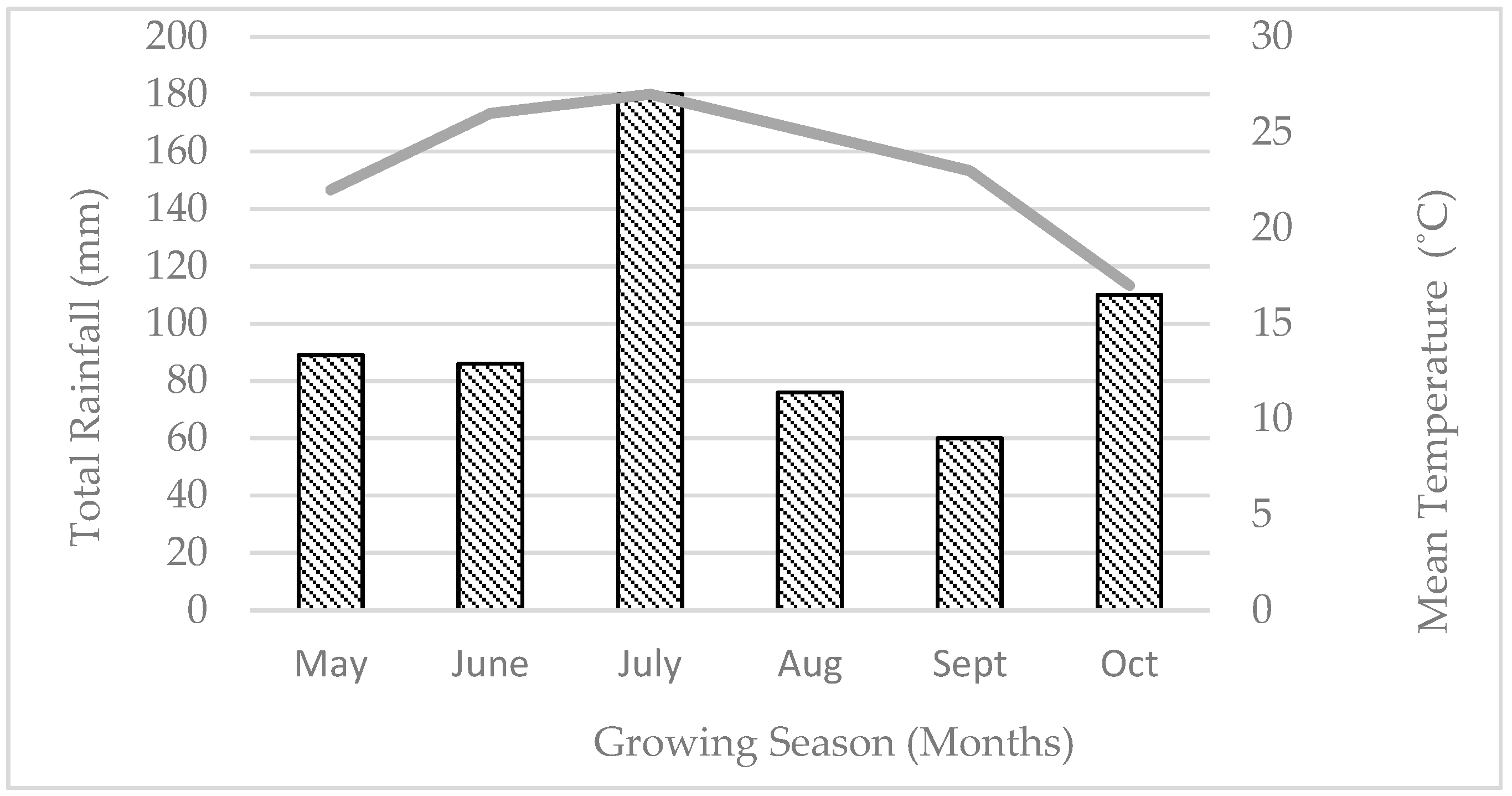
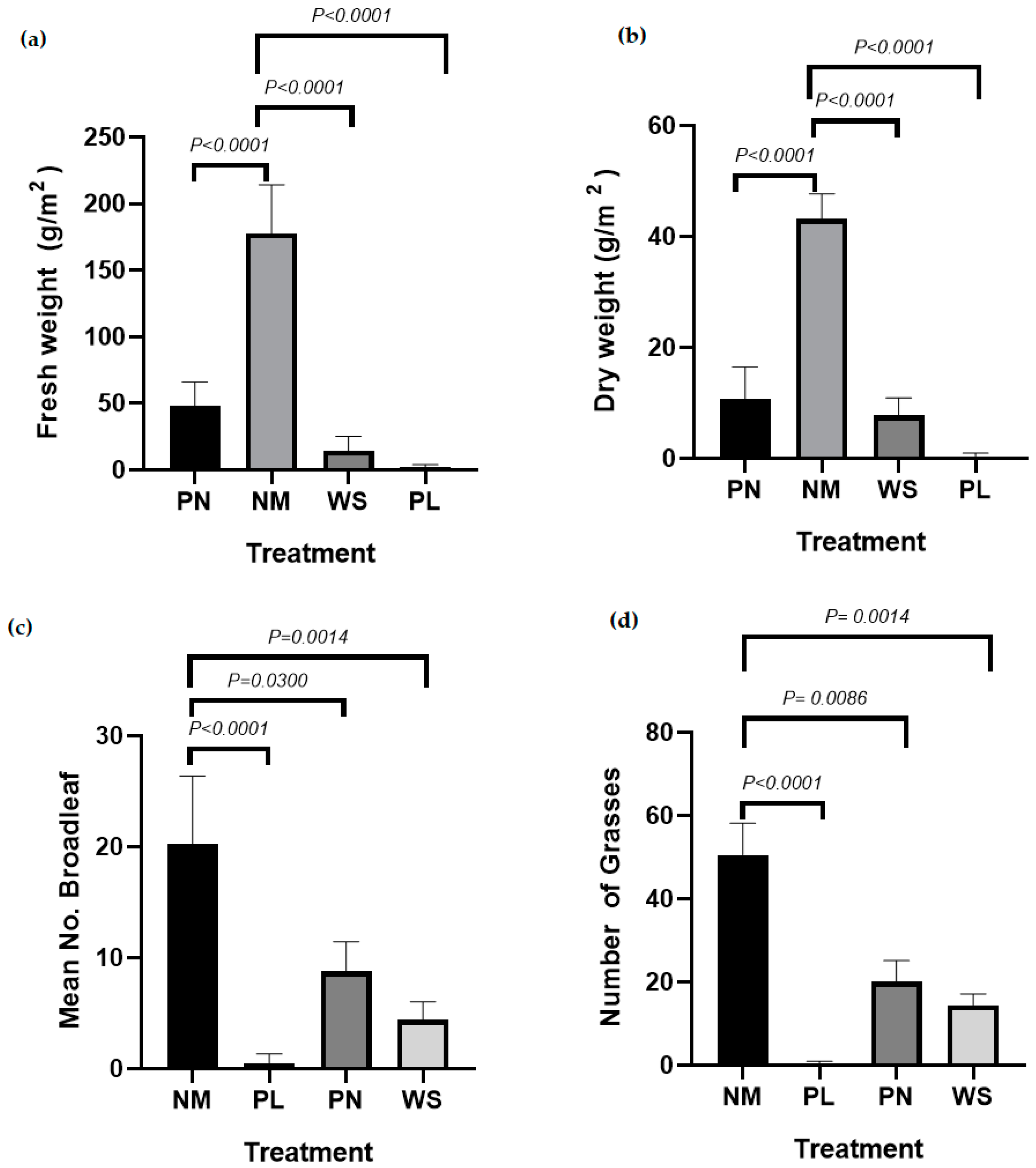
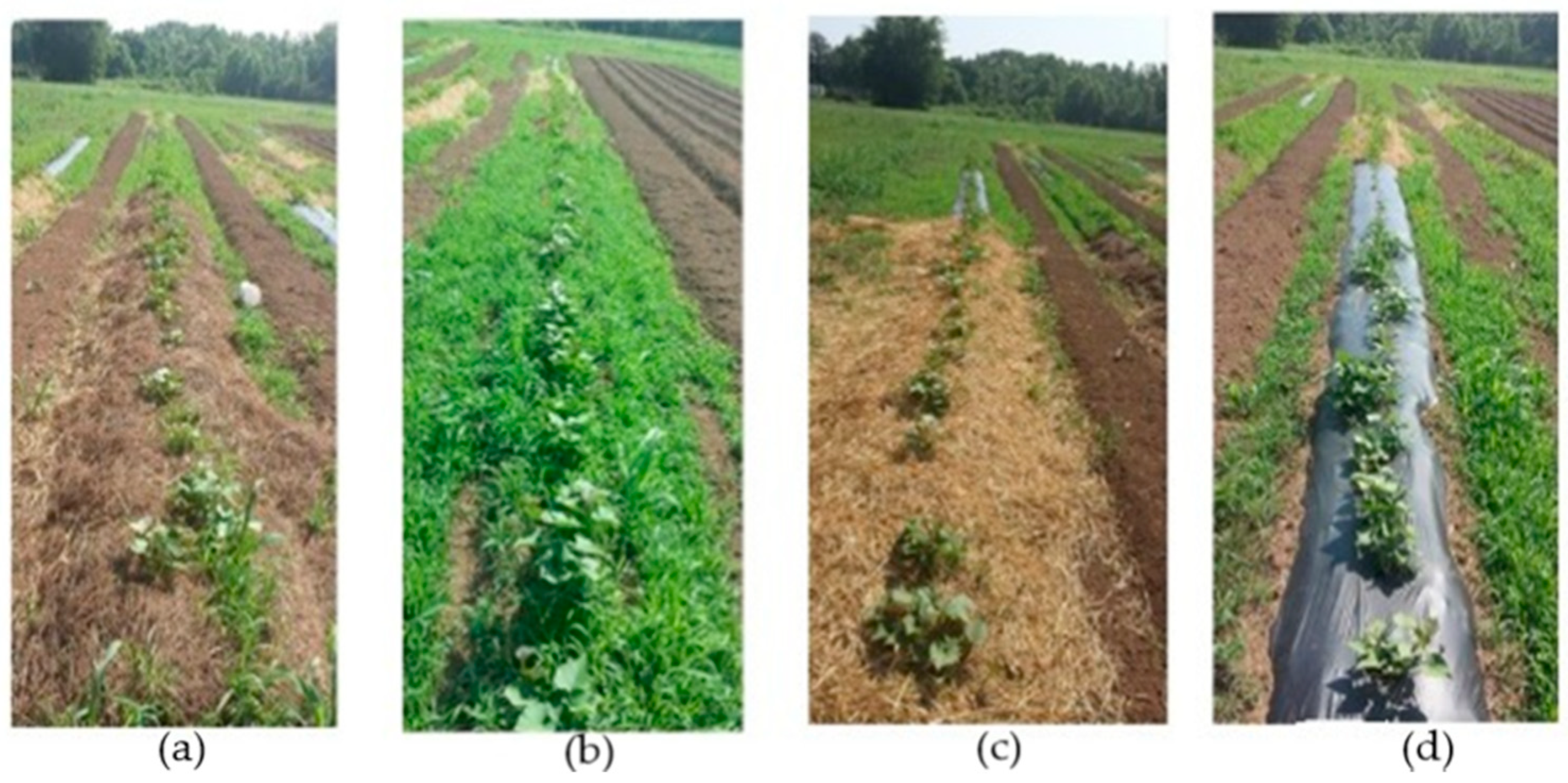
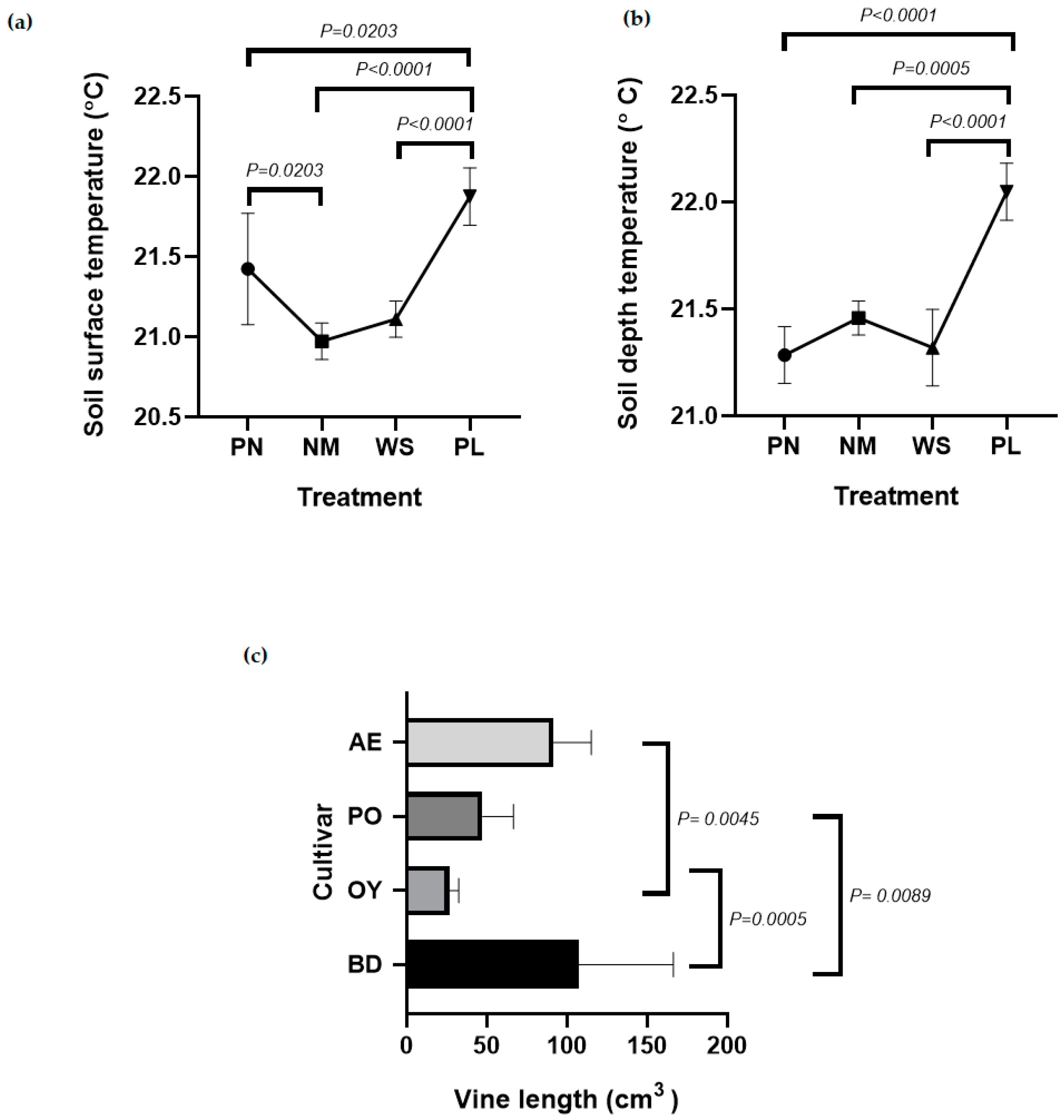
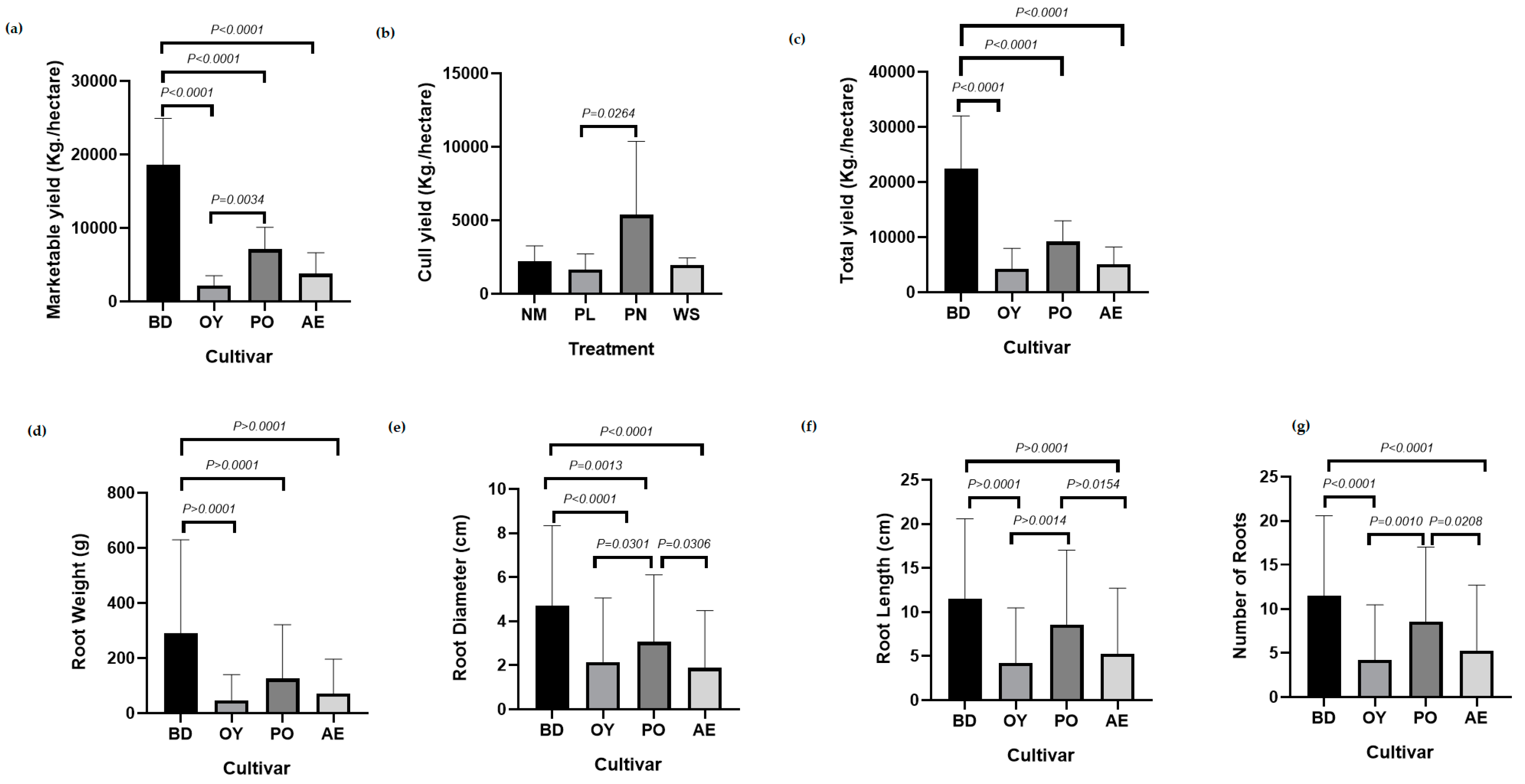
| Source | df | F Value | Pr > F | Significance | |
|---|---|---|---|---|---|
| A | Dry weight (g/m2) | ||||
| Cultivar | 3 | 0.2764 | 0.8421 | ns | |
| Treatment | 3 | 26.48 | p < 0.0001 | *** | |
| Errors | 48 | ||||
| B | Fresh weight (g/m2) | ||||
| Cultivar | 3 | 2.247 | 0.3508 | ns | |
| Treatment | 3 | 63.49 | p < 0.0001 | *** | |
| Errors | 48 | ||||
| C | Broad leaves (no.) | ||||
| Cultivar | 3 | 0.2849 | 0.8361 | ns | |
| Treatment | 3 | 9.095 | p < 0.0001 | *** | |
| Errors | 48 | ||||
| D | Grasses (no.) | ||||
| Cultivar | 3 | 0.2766 | 0.8420 | ns | |
| Treatment | 3 | 10.67 | < 0.0001 | *** | |
| Errors | 48 | ||||
| Source | df | F Value | Pr > F | Significance | |
|---|---|---|---|---|---|
| A | Soil surface temperature (°C) | ||||
| Cultivar | 3 | 0.6757 | 0.5712 | ns | |
| Treatment | 3 | 14.37 | < 0.0001 | *** | |
| Errors | 48 | ||||
| B | Soil depth temperature (°C) | ||||
| Cultivar | 3 | 0.5957 | 0.6209 | ns | |
| Treatment | 3 | 13.36 | < 0.0001 | *** | |
| Errors | 48 | ||||
| C | Vine length (cm3) | ||||
| Cultivar | 3 | 10.04 | 0.0003 | *** | |
| Errors | 21 | ||||
| Source | df | F Value | Pr > F | Significance | |
|---|---|---|---|---|---|
| A | Diameter (cm3) | ||||
| Cultivar | 3 | 9.687 | < 0.0001 | *** | |
| Treatment | 3 | 1.549 | 0.2026 | ns | |
| Errors | 231 | ||||
| B | Length (cm3) | ||||
| Cultivar | 3 | 11.38 | < 0.0001 | *** | |
| Treatment | 3 | 2.094 | 0.1016 | ns | |
| Errors | 240 | ||||
| C | Weight (g/m2) | ||||
| Cultivar | 3 | 18.16 | < 0.0001 | *** | |
| Treatment | 3 | 1.253 | 0.2911 | ns | |
| Errors | 240 | ||||
| D | Number (no.) | ||||
| Cultivar | 3 | 11.65 | < 0.0001 | *** | |
| Treatment | 3 | 1.512 | 0.2235 | ns | |
| Errors | 48 | ||||
| Source | df | F Value | Pr > F | Significance | |
|---|---|---|---|---|---|
| A | Marketable Yield (kg/ha) | ||||
| Cultivar | 3 | 64.22 | < 0.0001 | *** | |
| Treatment | 3 | 1.140 | 0.3426 | ns | |
| Errors | 48 | ||||
| B | Cull Yield (kg/ha) | ||||
| Cultivar | 3 | 2.682 | 0.0580 | ns | |
| Treatment | 3 | 3.562 | 0.0214 | *** | |
| Errors | 48 | ||||
| C | Total Yield (kg/ha) | ||||
| Cultivar | 3 | 36.91 | < 0.0001 | *** | |
| Treatment | 3 | 1.419 | 0.2487 | ns | |
| Errors | 48 | ||||
© 2019 by the authors. Licensee MDPI, Basel, Switzerland. This article is an open access article distributed under the terms and conditions of the Creative Commons Attribution (CC BY) license (http://creativecommons.org/licenses/by/4.0/).
Share and Cite
Nwosisi, S.; Nandwani, D.; Hui, D. Mulch Treatment Effect on Weed Biomass and Yields of Organic Sweetpotato Cultivars. Agronomy 2019, 9, 190. https://doi.org/10.3390/agronomy9040190
Nwosisi S, Nandwani D, Hui D. Mulch Treatment Effect on Weed Biomass and Yields of Organic Sweetpotato Cultivars. Agronomy. 2019; 9(4):190. https://doi.org/10.3390/agronomy9040190
Chicago/Turabian StyleNwosisi, Sochinwechi, Dilip Nandwani, and Dafeng Hui. 2019. "Mulch Treatment Effect on Weed Biomass and Yields of Organic Sweetpotato Cultivars" Agronomy 9, no. 4: 190. https://doi.org/10.3390/agronomy9040190
APA StyleNwosisi, S., Nandwani, D., & Hui, D. (2019). Mulch Treatment Effect on Weed Biomass and Yields of Organic Sweetpotato Cultivars. Agronomy, 9(4), 190. https://doi.org/10.3390/agronomy9040190






